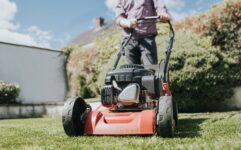
These Are the Most Dangerous Lawn and Garden Tools
Lawn care is a routine, seemingly innocuous, yet potentially dangerous activity for many homeowners. According to a recent Lawnstarter survey, nearly 3 million U.S. residents have been injured as a result of working in their lawn or garden, with 21 percent of respondents sustaining a serious injury.
Combined, common garden tools, such as hoses, leaf blowers, pruning shears, wheelbarrows, and chainsaws, are involved in the majority of accidents, but lawnmowers alone are responsible for a significant number of injuries, most of which require surgery. Additionally, lifting, kneeling, squatting, and bending over while using lawn and garden tools can cause harm. The same goes for neglecting to wear protective gear and incorrect tool handling.
Lawn care safety is paramount when doing yard work. Some basic, common-sense habits can prevent many injuries—starting with following manufacturer specifications for equipment operation and maintenance.
Mowers

Mowing injuries typically consist of burns, cuts, fractures, projectile/missile injuries, and amputations. Fall injuries can also occur.
To prevent most injuries, survey the area before mowing and remove any obstacles, advises Josh Payne, owner of landscaping company, Classic. “Hidden debris can become projectiles, so caution around play equipment, furniture, and other items is key.”
Higher mower settings minimize the risk of accidentally hitting objects and helps to mulch grass clippings better. Sharpen blades and secure guards to make sure the mower runs smoothly.
Keep children and pets inside while mowing; don’t cut wet or damp grass; take caution on slopes; and wear close-toed shoes, long pants, and protective eyewear.
String Trimmers/Weed Eaters

String trimmers, also known as weed eaters, feature a heavy-gauge plastic line that whips around at high speed. It can cause deep cuts, eye injuries, or even amputation if you’re not careful.
“For string trimmers,” says Scott McLeod, owner of McLeod Landscaping Inc., “we use a shoulder strap, full-finger gloves, and eye shield.” Closed-toed shoes and long sleeves are also recommended. Do not wear baggy clothing that can get caught in the string and make sure to check the area for hidden debris or loose items before getting to work. Use the string trimmer only while standing on the ground and don’t lift it above your head.
Pruners

Pruning can involve a number of different tools: loppers, shears, saws, pole saws, pole pruners, and more. Injuries from pruning may include falls, lacerations, slips, head or eye injuries, back or shoulder strains, and repetitive motion injuries. Injury from falling branches is an additional hazard.
Safety procedures start with inspecting tools, says Matthew Wilson, lawn care expert and CEO of Handy Gardeners. Make sure they are clean, sharp, and functioning properly.
“Use ladders safely,” Wilson adds. Choose the right type of ladder for the job; place it on solid, level ground; have a helper hold it; and never overextend your reach. Don’t prune within 10 feet of power lines to minimize the risk of electrical shock.
Chainsaws

Self-inflicted wounds are common from these motorized tools. According to Consumer Reports, more than 40 percent of serious injuries from chainsaws are lacerations to the arms, legs, hands, and feet. Finger amputations comprise 6 percent of hospital admissions. Additional injuries can be incurred from falling tree limbs.
To prevent injuries, do not wear loose clothing that could get caught in the chainsaw. Steel-toed boots are recommended, as are gloves and a helmet with a face shield. Ear protection is a good idea, because saws typically operate above 85 decibels—enough to cause hearing damage.
Stand on the ground, don’t overreach, don’t cut limbs larger than 6 inches in diameter, and avoid sawing with the tip of the chain and bar, where kickback typically occurs.
Leaf Blowers

Leaf blowers output high-speed airflow and a lot of noise. This can cause flying debris accidents and damaged hearing.
Gas leaf blowers emit hazardous chemicals that include fine particulate matter, formaldehyde, benzine, and smog-forming pollutants, Wilson lists. “These toxins have been linked to health problems including dizziness, headaches, asthma attacks, heart and lung illness, cancer, and dementia.”
For noise pollution, Wilson advises wearing earplugs. Dust masks can assist with noxious fumes (alternatively, switch to an electric- or battery-powered leaf blower that doesn’t emit hazardous fumes). Check for pets, children, and other items in the pathway of the wind before using a leaf blower to reduce risk of airborne debris and injuries.
Pressure Washers

Pressure washers can blast streams of water up to 80 times the force a garden hose applies. This can damage wood, paint, and the human body, causing lacerations, bruises, and strains. People who use a pressure washer while standing on a ladder to clean gutters can slip and fall.
Never use a gas-powered pressure washer indoors; carbon monoxide poisoning can result. Do not use a pressure washer when standing on a ladder and be careful of footing on wet surfaces to avoid falling. Wear personal protective equipment when using a pressure washer, like goggles, long pants, and closed-toed shoes. Additionally, you should never point the nozzle directly at anyone.

Gardening is hard work. Tools such as rakes, shovels, hoes, forks, trowels, and spades can cause minor injuries—typically cuts, bruises, punctures, and strains/sprains to the lower back, shoulder, neck, and wrist.
Always wear proper protective gear when using hand tools for gardening. Gloves often provide better grip, which also prevents injury. Keep tools sharp and in good condition to make sure they’re working well and use them correctly for their intended purpose, incorporating the proper grip and technique. Safely store hand tools to avoid stepping on them and never leave them unattended in the garden.



